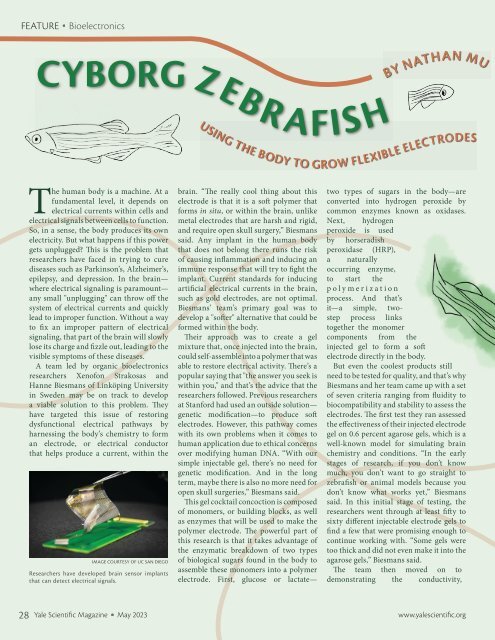YSM Issue 96.2
Create successful ePaper yourself
Turn your PDF publications into a flip-book with our unique Google optimized e-Paper software.
FEATURE<br />
Bioelectronics<br />
CYBORG ZEBR AFISH<br />
BY NATHAN MU<br />
USING THE BODY TO GROW FLEXIBLE ELECTRODES<br />
The human body is a machine. At a<br />
fundamental level, it depends on<br />
electrical currents within cells and<br />
electrical signals between cells to function.<br />
So, in a sense, the body produces its own<br />
electricity. But what happens if this power<br />
gets unplugged? This is the problem that<br />
researchers have faced in trying to cure<br />
diseases such as Parkinson’s, Alzheimer’s,<br />
epilepsy, and depression. In the brain—<br />
where electrical signaling is paramount—<br />
any small "unplugging" can throw off the<br />
system of electrical currents and quickly<br />
lead to improper function. Without a way<br />
to fix an improper pattern of electrical<br />
signaling, that part of the brain will slowly<br />
lose its charge and fizzle out, leading to the<br />
visible symptoms of these diseases.<br />
A team led by organic bioelectronics<br />
researchers Xenofon Strakosas and<br />
Hanne Biesmans of Linköping University<br />
in Sweden may be on track to develop<br />
a viable solution to this problem. They<br />
have targeted this issue of restoring<br />
dysfunctional electrical pathways by<br />
harnessing the body’s chemistry to form<br />
an electrode, or electrical conductor<br />
that helps produce a current, within the<br />
IMAGE COURTESY OF UC SAN DIEGO<br />
Researchers have developed brain sensor implants<br />
that can detect electrical signals.<br />
brain. “The really cool thing about this<br />
electrode is that it is a soft polymer that<br />
forms in situ, or within the brain, unlike<br />
metal electrodes that are harsh and rigid,<br />
and require open skull surgery,” Biesmans<br />
said. Any implant in the human body<br />
that does not belong there runs the risk<br />
of causing inflammation and inducing an<br />
immune response that will try to fight the<br />
implant. Current standards for inducing<br />
artificial electrical currents in the brain,<br />
such as gold electrodes, are not optimal.<br />
Biesmans’ team’s primary goal was to<br />
develop a "softer" alternative that could be<br />
formed within the body.<br />
Their approach was to create a gel<br />
mixture that, once injected into the brain,<br />
could self-assemble into a polymer that was<br />
able to restore electrical activity. There’s a<br />
popular saying that "the answer you seek is<br />
within you," and that’s the advice that the<br />
researchers followed. Previous researchers<br />
at Stanford had used an outside solution—<br />
genetic modification—to produce soft<br />
electrodes. However, this pathway comes<br />
with its own problems when it comes to<br />
human application due to ethical concerns<br />
over modifying human DNA. “With our<br />
simple injectable gel, there’s no need for<br />
genetic modification. And in the long<br />
term, maybe there is also no more need for<br />
open skull surgeries,” Biesmans said.<br />
This gel cocktail concoction is composed<br />
of monomers, or building blocks, as well<br />
as enzymes that will be used to make the<br />
polymer electrode. The powerful part of<br />
this research is that it takes advantage of<br />
the enzymatic breakdown of two types<br />
of biological sugars found in the body to<br />
assemble these monomers into a polymer<br />
electrode. First, glucose or lactate—<br />
two types of sugars in the body—are<br />
converted into hydrogen peroxide by<br />
common enzymes known as oxidases.<br />
Next, hydrogen<br />
peroxide is used<br />
by horseradish<br />
peroxidase (HRP),<br />
a naturally<br />
occurring enzyme,<br />
to start the<br />
p o l y m e r i z a t i o n<br />
process. And that’s<br />
it—a simple, twostep<br />
process links<br />
together the monomer<br />
components from the<br />
injected gel to form a soft<br />
electrode directly in the body.<br />
But even the coolest products still<br />
need to be tested for quality, and that’s why<br />
Biesmans and her team came up with a set<br />
of seven criteria ranging from fluidity to<br />
biocompatibility and stability to assess the<br />
electrodes. The first test they ran assessed<br />
the effectiveness of their injected electrode<br />
gel on 0.6 percent agarose gels, which is a<br />
well-known model for simulating brain<br />
chemistry and conditions. “In the early<br />
stages of research, if you don’t know<br />
much, you don’t want to go straight to<br />
zebrafish or animal models because you<br />
don’t know what works yet,” Biesmans<br />
said. In this initial stage of testing, the<br />
researchers went through at least fifty to<br />
sixty different injectable electrode gels to<br />
find a few that were promising enough to<br />
continue working with. “Some gels were<br />
too thick and did not even make it into the<br />
agarose gels,” Biesmans said.<br />
The team then moved on to<br />
demonstrating the conductivity,<br />
28 Yale Scientific Magazine May 2023 www.yalescientific.org

















